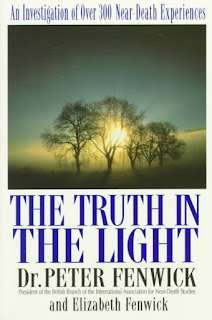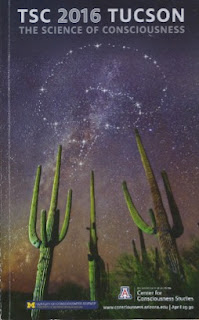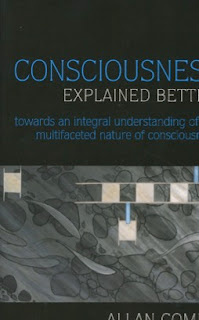I first bought the large edition of Jung’s long-awaited tome with its magnificent facsimiles of artwork and calligraphy. Both mesmerized and bewildered, I tried to read Sonu Shamdasani's introduction at the back of the book, but it was too large to be functional. Finally, I learned that
A Reader's Edition existed. This was manageable and utterly essential to marking passages in the text and taking notes on Shamdasani's invaluable introduction and footnotes. As Shamdasani says, everything Jung ends up saying in future books did indeed come out of this early hallucinatory experience which began during the same time that André Breton and his Surrealist circle were experimenting with their own automatisms and Frederic Myers, Théodore Flournoy and Pierre Janet were studying famous spirit mediums. W.B. Yeats was engaged in séances with his wife, George, as his medium and Jung had a copy of the resulting text:
A Vision. The paranormal was in the air and spirit contact was actively pursued.
As I attempted to show in my book,
In Their Right Minds: The Lives and Shared Practices of Poetic Geniuses, not everyone has the ability to receive visions, make a planchette move over a Ouija Board, or get answers in a séance. It requires an atypical mind with enhanced right-hemispheric functioning and a partner. Jung fits the mold. First, he had a genetic predisposition to internal division. His mother had two personalities, No. 1 and No. 2; his grandfather, and his cousin, whose séances and splits he studied and encouraged, had the same dissociative tendencies. As a young boy, Jung felt divided between a depressive lonely self and a spirit from an earlier historical period. At the environmental level, Jung suffered from early maternal attachment issues that have been shown to presage a split personality resembling schizophrenia, but more rightly termed dissociation.
On a grander scale, the impending World War threatened his psyche. He had horrific precognitive visions in tandem with his professional break with Freud and an extra-marital relationship with Toni Wolff, who lived in his house as a second wife and shared merged dream states and fantasies with him.* Including his professional interest in troubled minds, we can understand why he felt compelled to write, in painstaking calligraphy, in Latin and German, the words he heard; then illustrated them with brightly colored, tightly controlled, symbolic imagery. As a female voice told him, it was not science, it was art. Further, it was art in service to a suppressed conscious mind.


Jung himself said he felt threatened with madness.** Environmental circumstances reinforced his intention to explore his own psyche through visions and imaginary dialogues. Based on my research into the minds of poetic geniuses, I would say Jung was predisposed to dissociate because of his bilateral brain organization, with neither side dominant, as environmental stressors pushed him over the edge. His use of right-hemispheric poetic writing and highly symbolic, vertically oriented, left-hemispheric painting helped him regain his equilibrium. Both highly verbal and artistic, he retained a helping figure, Philemon, who walked and talked with him, until he was no longer needed.
Michael Persinger associates a sense of presence with synchronous activation of both hemispheres.

One of Jung’s early patients provides evidence of a how this type of mind might work. In
Memories, Dreams, Reflections, written by Aniela Jaffé using Jung’s notes, much of which ended up on the cutting room floor, we learn of a female patient who heard voices. She described a voice in the middle of the thorax as ‘God’s voice.’ Her other voices were distributed on both sides of her body. The ‘divine’ voice commanded that Bible chapters be assigned before each therapeutic session followed by a test. After six years of therapy, the voices ‘had retired to the left half of her body, while the right half was free of them (127).'" Both sides could speak, with more negativity coming from the right hemisphere; but the left hemisphere, focused on reading and reciting, had healed.

Neuropsychologist D. W. Harrison, writing in 2015, confirms that hallucinations experienced on the left side of the body are negative and coming from the right hemisphere; those experienced on the right are coming from the positive left hemisphere (the proverbial demon on one shoulder, the angel on the other). While writing
The Red Book, Jung referred to left- versus right-sided visions. For instance, he describes a vision of a winged being sailing across the sky, coming from the right (= LH provenance), a guru with superior insight, as Shamdasani described him. Jung maintained his therapeutic practice and professional and family activities, retiring to his study in the evenings to engage with his voices and visions.
Even as a child, Jung had been a voracious reader. So, it is not surprising that his readings entered into the dramas he evoked through “active imagination.” Shamdasani traces these influences very well, which included the Bible, Swedenborg, Nietzsche and Dante, in his footnotes to
The Red Book. Jung admired art as well. William Blake was an influence, although Jung criticized his predecessor's drawings as artistic rather than an “authentic representation of unconscious processes (Letters 2. Pp. 513-14).” Jung also admired Odilon Redon’s symbolist paintings. The Basilica of Sant'Apollinare in Ravenna, Italy, had a strong impact on Jung (as it had on poet and occultist James Merrill who spent 20 years in Ouija Board sessions with his partner, David Jackson). The frescos and mosaics there translated into Jung’s own “strong colors, mosaic-like forms, and two dimensional figures without the use of perspective (34)."

Parapsychological events occurred in Jung’s house that affected everyone in it. In Shamdasani’s account, Jung’s son raved in his sleep and couldn’t wake up. Asked for paper and colored pencils, he drew “a man angling for fishes with hook and line in the middle of the picture.” Again the left/right emotional divide is evident: on the left was the Devil saying something to the man, but on the right was an angel. Two of Jung’s daughters “thought they had seen spooks in their rooms.” The next day Jung wrote his “Sermons to the Dead,” claiming in
Memories, Dreams, Reflections that the haunting stopped as soon as he picked up the pen.

Parapsychological events often occur when a strong emotion trapped inside needs to come out. Poltergeist phenomena in adolescent children have been described this way. Both St. Augustine and French writer George Sand claimed to have heard the words "Tolle, Lege" [Pick up and read] from an external voice, leading to a change in life course. She also had an ambiguously gendered inner figure named Corambé with whom she communicated as a child. This figure disappeared after she wrote her first book in a dissociative state. In times of great stress, inner voices can save a suffering soul. What they and we are all seeking is meaning and a way forward in difficult times.
Were Jung's Sermons “a curiosity from the workshop of the unconscious,” as he would later say, or was there a deeper meaning? What was the strong need to get those words and images on paper? And who was their author? Shamdasani says Jung’s “I" was the author in the "Black Books" section, but it was Philemon in “Scrutinies.” In some sections of Liber Novus it is was the serpent or the bird. The overall theme was “how Jung regains his soul and overcomes the contemporary malaise of spiritual alienation. This is ultimately achieved through enabling the rebirth of a new image of God in his soul and developing a new worldview in the form of a psychological and theological cosmology (Shamdasani 48).” In every poet I have studied who held dissociative discourses with "spirits," the end result included a "new" religion.
In my view, as reason gives way to the irrational, a deeper associative meaning can be uncovered, suggesting, in modern neuroscientific terms, a shutdown of the prefrontal cortex where conscious thought is processed, now expressed through symbols and imagery. The logical left hemisphere is giving way to the mythopoeic right that has similarly informed important religious figures in the past.

Was Jung mad? Richard Hull, Jung’s translator, wrote to William McGuire, who represented Princeton UP papers, saying but for Jung's “hammer[ing] out his experience into a system of therapy that works,” he’d be considered “as mad as a hatter.” Further, “[t]he raw material of his experience is Schreber’s*** world over again; only by his powers of observation and detachment, and his drive to understand, can it be said of him what Coleridge said in his notebooks of a great metaphysician . . . He looked at his own Soul with Telescope / What seemed all irregular, he saw & shewed to be beautiful Constellations & he added to the Consciousness hidden worlds within worlds (March 17, 1961, Bollingen archives, Library of Congress). The citation from Coleridge was indeed used as a motto for
Memories, Dreams, Reflections (see fn. 257, p. 94 in
The Red Book: A Reader’s Edition).”
By Liber Secundus, Jung seems sure of the Power of the Divine Word that others before him had also received. Writing down the Divine Word protects against “the daimons of the unending, which tear at your soul and want to scatter you to the winds. You are saved if you can say at last: that is that and only that. You speak the magic word, and the limitless is finally banished. Because of that men seek and make words (250).”
From my vantage as a reader of Jung’s text, it often does sound mad, with anomalous sense impressions common to psychotic episodes, including his recognizing highly significant messages that nonetheless cannot be understood because they are seen in unusual scripts such as hieroglyphics. The frightening sound of flapping bird wings as well as seeing “shadow forms” are also common. The accent on negativity that Jung hears in his
left ear with the word “Misfortune” also shows right-hemispheric provenance. When the God calls to him, the voice is coming from
both sides, which Jung interprets as a middle road; but more likely, it is a synchronization of the hemispheres known to occur in oneness experiences, where a sense of self is lost or the self and the divine are felt as coterminous. The very sense that he is working “against will and intention,” manipulated by an external source, is telling.
Underneath all of the imagery and voices, three things shine through to me: his mother complex, from which he needed to be freed; his conflicted relationship to his pastor father's religion; and the legitimization of his extra-marital relationship with Toni Wolff. When Elijah gives Salome to Jung in
The Red Book, he says, “For God’s sake, what should I do with Salome. I am already married and we are not among Turks (435).” Yet a dream will convince him to enter into a sexual relationship with her. The fact that “[a] turbaned Mohammad appears the fourth night after Philemon went away, wearing a long coat and a turban, claiming to bring ‘the bliss of paradise, the healing fire, the love of women (539)” is as telling as Jung’s interpretation of “Philemon’s words that I must remain true to love to cancel out the commingling that arises through unlived love. I understood that the commingling is a bondage that takes the place of voluntary devotion. . . . I had to remain true to love, and, devoted to it voluntarily (540).”
In his epilogue to
Liber Novus, Jung wrote that he had worked on the book for 16 years, and then yielded to a study of alchemy, which helped him understand what he had written. He admitted, “To the superficial observer, it will appear like madness. It would also have developed into one, had I not been able to absorb the overpowering force of the original experiences (555).”
A synthesis of supposedly opposing forces occurs in an appendix to
Liber Novus: “Logos [male] and Eros [female] are reunited, as if they had overcome the conflict between spirit and flesh. They appear to know the solution. The movement toward the left, which started from Eros at the beginning of the image, now commences from Logos. He starts moving toward the left [the heart side], to complete with seeing eyes what began in blindness (571).”
A final note on the issue of madness:
Dirk Corstens, head of the Hearing Voices Network in the Netherlands, does not believe that schizophrenia exists at all; rather, voices are a feature of dissociation, which originates in trauma. The “madness” comes by way of a fearful reaction to the voices. If one engages with the voices, reasons with them, they can be cajoled, tamed, and reduced to harmless or even helping presences. I believe this is what happened in Jung’s case. Through his calligraphy and art, he tamed his mind, bringing about his own healing as well as a system that could and does work for so many others.
*According to Shamdasani's research, while Toni Wolff was in analysis with Jung, she was having incredible fantasies. Jung wrote that "her phantasies entered exactly into my line of thought. Toni Wolff was experiencing a similar stream of images. I had evidently infected her, or was the déclencheur that stirred up her imagination. My phantasies and hers were in a participation mystique. It was like common stream, and a common task [April 1-2, 2011 seminar, Jung Center of Houston]."
**
Michael Cornwall believes psychotic episodes should rather be termed spiritual states of emergency better treated with compassionate listening than pharmaceuticals. Paranormal connections such as precognition and voices with important messages are frequently reported in these states.
***Daniel Paul Schreber was a German lawyer and judge who had experienced severe trauma as a child because of his father's onerous child-rearing practices. His brother, under the same regime, committed suicide. Schreber passed through several phases of severe mental illness, hearing voices and developing strange views in a very God-driven narrative, leading to his institutionalization. He was eventually released because of his book, and lived peacefully with his wife for some time. But, when she fell victim to a stroke, he relapsed and spent the rest of his life in the asylum. Freud blamed Schreber's illness on repressed homosexual attraction to his own father. Jung disagreed, ascribing Schreber's case to an identification with female fecundity, as he and his wife had not been able to have children. Childhood trauma and current stressors were certainly behind his relapses. Cruel treatments by the director of the asylum and his wife's lack of visits only contributed to his gender dysphoria and delusions of grandiosity.
Apparently, gender identity confusion is fairly common in schizophrenia, bipolar disorder, as well as in
dissociative identity disorder. The voices were, in effect, a way to "make sense" of what he was feeling. Similarly to Jung, Schreber described a left ear connection: "inimical souls always aspired towards my head, on which they wanted to inflict some damage, and sat particularly on my left ear in a highly disturbing manner. To his credit, Freud did say that Schreber's delusions were "
an attempt at recovery, a process of reconstruction" (see Rosemary Dinnage's introduction to Schreber's book).



























